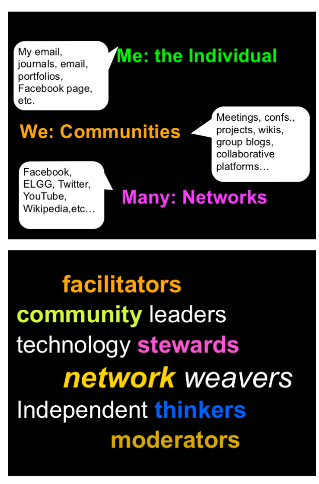Role of the learner: technology stewards

The online community allows for dynamic interaction between tasks, instructors and learners. Instructors and moderators undertake the role of facilitators, asking questions and supporting interactions, and can be equally involved in learning from each other (Holt and Willard-Holt 2000). As Herrington et al., (2010 p.23) contended, often it is the person who has recently acquired the skill who is the best position to share the key elements of the constructs.
Kirkwood (2006) suggests the learning affordances of Web 2.0 applications (such as wikis, blogs, and social bookmarking) assist the self-organizing creation of CoPs as self- regulating knowledge networks in which individuals are motivated to participate. In negotiating these, members become enculturated into the community’s practices, language, and behaviours. Numerous commentators have stressed the importance of including some face-to-face communication in a virtual CoP in order to build trust (Kimble et al., 2000).
More about the changing nature of knowledge in online environments: https://opentextbc.ca/teachinginadigitalage/chapter/section-2-4-does-technology-change-the-nature-of-knowledge/
The website and blog complementing the book, Digital Habitats: stewarding technology for community (Wenger et al., 2009): http://technologyforcommunities.com/
Image source:
Nancy White (http://www.fullcirc.com/) : https://www.slideshare.net/elsua/communitybuilders-online-community-still-crazy-after-years-with-nancy-white
References:
Herrington, J., Reeves, T.C. and Oliver, R. (2010) A Guide to Authentic e-Learning. Routledge, New York.
Holt, D. G.; Willard-Holt, C. (2000). "Lets get real – students solving authentic corporate problems". Phi Delta Kappan 82 (3)
Kimble, C., Hildreth, P. & Wright, P. (2001). Communities of Practice: Going Virtual. In Y. Malhotra (Ed.) Knowledge management and business innovation, Hershey, PA: Idea Group (220-234).
Kirkwood, A. and Price, L., 2006. Adaptation for a changing environment: Developing learning and teaching with information and communication technologies. The International Review of Research in Open and Distributed Learning, 7(2).
Lave, J. & Wenger, E. (1991). Situated Learning: Legitimate Peripheral Participation. Cambridge University Press.
Wenger, E., White, N. and Smith, J.D., 2009. Digital habitats: Stewarding technology for communities. CPsquare.
Wenger, E., White, N. and Smith, J.D., 2009. Digital habitats: Stewarding technology for communities. CPsquare.

